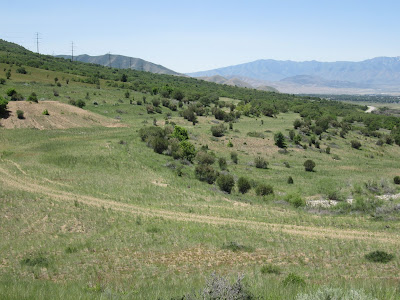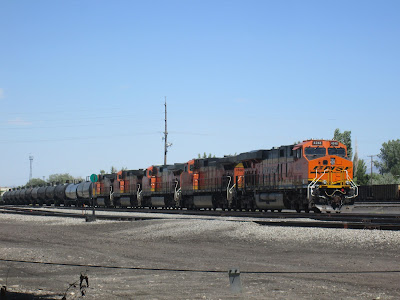August 9, 2016; five BNSF locomotives stand at the ready facing south in Provo Yard.
Today has been a bit busy on this blog, and depending on when I finally finish this post it might be one of several posts from the different contributors today. As nice as it would be to wait a bit to write another post later this week, my schedule means today is the only day I have time to write anything on here until Saturday.
Also thinking of different subjects I could perhaps provide insight into, I was met with a myriad of ideas. My longterm goal is to get a nice post (or series) talking about my hometown Tooele Valley Railway, but I want time to polish my ideas before I publish info on a subject I find so endearing. I have also considered a few other ideas, but I just need time to find the info and take photos for those subjects.
Fortunately I decided the subject of the unique relation between the Utah Railway and BNSF is something I have learned and witnessed a lot of over the past few months. My move from Logan to Salt Lake has meant I am finally within the territory that BNSF and Utah Railway serve. I actually wasn't able to get great photos of the BNSF until recently with this move. While both Schon and Josh are probably a bit more familiar with these trains than I am due to their locations, I hope that my bit of insight will help those curious as to how BNSF operates in Utah; and could perhaps be used as a spring board for future posts from either myself or them.

One of my first photographs of the BNSF was taken on July 30, 2011 in Nevada somewhere paralleling Interstate 80 while on a family vacation. I was riding in the backseat of a car, and for the next few years the only time I would see BNSF trains was either when I was in the backseat of a moving car with my family, or worse; without my camera. It wasn't until the vital help of social media allowing me to contact local railfans that I finally was able to figure out how to track down the BNSF.
Before 1982, Utah was the crossroad point for four vital interstate railroads; the Union Pacific, the Denver and Rio Grande Western, the Southern Pacific, and the Western Pacific. Among them ran regional railroads such as Utah Railway, or Kennecott Copper's massive private electric railroad line. The railroad scene in downtown Salt Lake and Ogden was vibrant, as these different railroads intersected and changed cars with each other. Many Utah towns had access to one or two of these different railroads.
A sample look at a few of the locomotives representing the railroads of Utah before the mergers that consolidated them all under the Union Pacific name. The first photo was taken on August 1, 2011; and showcases the preserved Western Pacific 805 in Portola California.
The second photo shows the last Southern Pacific locomotive that ran on Union Pacific rails with it's original paint and number; SP 343. This photo was taken in Erda, Utah on April 4, 2016. This day would be both the first and last time I (among with a few other railfans) would see this unit. A few months later, it would be painted into the Armour Yellow and Harbor Mist paint of the Union Pacific.
The third photo showcases two of the preserved locomotives at Ogden Union Station on November 29, 2015. DRGW 5371 to the left, and SP 7457 to the right. Both show evidence of cosmetic restoration on their noses, work which was provided by Kerry and Derrick Klarr, and Chris Fussell.
1982 and 1983 marked the beginning of an era of mergers that would last until 1996. The Western Pacific was consolidated (along with the Missouri Pacific) into the Union Pacific brand. 1989 brought about the merger of the Rio Grande with the Southern Pacific. 1996 brought about the final round of consolidations, as the Southern Pacific was absorbed into the Union Pacific.
The Southern Pacific and Union Pacific merger left a problem that had to be resolved, what to do to prevent a railroad monopoly by the Union Pacific in areas dominated previously by the two railroads? Utah was particularly at risk , as every single interstate railroad that crossed into it, had fallen under the Union Pacific banner. The only other rail competitor in the western USA, the newly formed BNSF railroad didn't have a single piece of track which crossed into Utah (or Nevada for that matter to). A concession granted by the federal government during the SP-UP merger made the Union Pacific grant the BNSF trackage rights into Utah and Nevada over the former Southern Pacific, Western Pacific, and Rio Grande routes from California to Colorado; with Utah as the middle ground. With this Utah Railway got the new role of running local freights, allowing BNSF freight dropped off in Provo to make it to industries through out the Wasatch Front and to local shortlines such as the Salt Lake Garfield and Western, and the Utah Central. This critical decision allowed competition to remain in the railroad transportation market in Utah.

On Patriot Day (September 11) 2016; Utah Railway 2008 a GP38-3 locomotive is switching cars for the soon to depart RUT 611 local. The RUT 611 takes cars delivered by the BNSF, and moves them from Provo to Ogden were they can be delivered to industries and transferred to the UCRY industrial shortline railroad.
Of course most of the time in Provo Yard, rather than use their own GP locomotives; Utah Railway crews tend to switch trains using power brought to them by the BNSF. Few railyards see GEVO's and SD70ACe units working switching jobs, let alone do they often see heritage units taking that job. But such was the case on August 9, 2016 when BNSF 6805 and Norfolk Southern 1073 the Penn Central Heritage unit, alongside NS 8401 were manned by the Utah Railway to switch cars that had just arrived on BNSF's Denver Colorado to Provo Utah train.
The BNSF bases most of their Utah activity in Provo Yard, sharing tracks with the Utah Railway. Their symbiotic relation is evident as Utah Railway crews often man BNSF locomotives to handle Utah Railway switching; and BNSF crews arrive to work in vans marked with the G&W (the parent company of the Utah Railway). While UP let's their aged GP units work yards, the Utah Railway and BNSF often let modern GEVO's and SD70ACe's do their yard switching. BNSF trains are stacked with lots of locomotives, ready to blast through the Union Pacific owned tracks, without causing delays for other trains on the line.


Look closely at these two photos. Both are the same train (a Provo to Lincoln Nebraska run) as seen on 9/11/16. The first photo was at Provo Yard, the second as seen north of Thistle on the former DRGW line. Taken only an hour and a half or so apart, there is evidence of BNSF's method of using lots of locomotives to a train and running it as fast as possible. The second photo shows on closer inspection that a fourth engine has been added to the consist, and that the addition was apparently fast enough it didn't cause significant delay to the train.
BNSF's process of fast freights running on the former DRGW and WP routes has lead many a railfan to comment that BNSF understand's how to run a railroad better than the often slow and under-powered trains of the Union Pacific. Other than the practical reasons of running fast trains, BNSF has also created a railfanning spectacle, as railfans bored of the monopoly of yellow engines, seek out the fast orange trains of the BNSF. It can be a bit of a race to follow these trains; as Josh can attest to ;)
Utah Railway 3000 passes Control Point 784 in downtown Salt Lake City, as it makes one of the many local jobs that Utah Railway operates in the area.
Other than their coal and oil trains down the old Rio Grande, Utah Railway's RUT 611 might perhaps be one of their flagship trains. The majority of the large six-axle road power of the Utah Railway continues to display their pre-G&W paint scheme, a unique combination of red and gray. Here the RUT 611 is taking it's train on Union Pacific's Main 3, formerly part of the Rio Grande mainline to Ogden.
Meanwhile the BNSF partnership has benefited the Utah Railway in a myriad of ways. With coal traffic reaching low levels, the Utah Railway still continues to find work transferring freight from the BNSF to local industries and other local shortline railroads. Many Salt Lake industries have the ability to chose to move their freight over the UP or the Utah Railway. This service provides competition in the railroad market for industries, and for railfans it helps to provide even more variety to the Utah railroading scene. Furthermore the Utah Railway (along with UTA and Savage) helps to operate nocturnal runs over tracks the Union Pacific abandoned after the mergers (but that is a story for another day.)
In conclusion, the BNSF and the Utah Railroad continue to provide competitive shipping to the Wasatch Front area. For railfans who missed out on the grand era of the DRGW, WP, SP and UP all calling Utah home; the Utah Railway and BNSF help to diversify the railroading scene. As these two railroads continue to work, they are defining what will someday be a notable part of railroad history in the early 21st century.
Nos Vemos
-Jacob
























































